Physical Address
304 North Cardinal St.
Dorchester Center, MA 02124
The diagnosis and management of skin diseases in the anogenital region may be complex. The juxtaposition of urinary, genital and alimentary tracts gives rise to special considerations at this site ( Fig. 73.1 ), and disease of any of these major systems may present with cutaneous manifestations. A number of systemic diseases such as Crohn disease and zinc deficiency preferentially affect the anogenital area. Local factors, including warmth, moisture, irritants, friction and the effects of body fluids, are important in this region, contributing to skin problems.
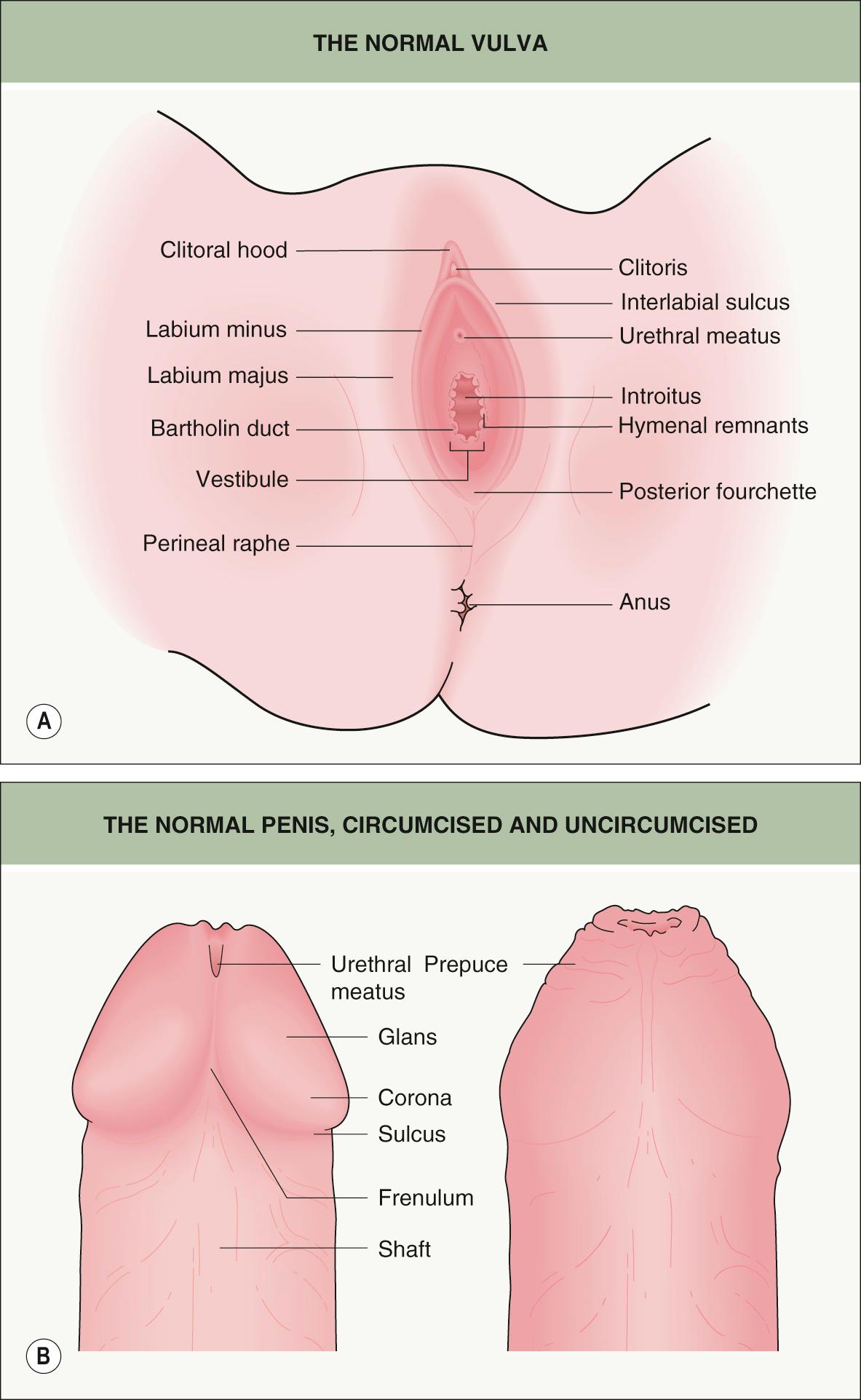
Skin conditions may be more difficult to diagnose in the anogenital region than at other cutaneous sites, as the typical appearance of a particular skin disease may be lacking and there may be a hesitation to perform biopsies. Examination of the scalp, nails and mouth frequently assists in diagnosis. Special considerations apply to treatment, as the natural occlusion of this area may increase the percutaneous absorption of topical corticosteroids, with the potential for cutaneous atrophy and/or hypothalamic–pituitary–adrenal axis suppression. Warmth and moisture may also increase the risk of bacterial and yeast infections.
Only a limited number of symptoms in the anogenital area are possible, and pruritus and genital pain may be the presenting feature of a wide variety of diseases.
▪ Lichen sclerosus et atrophicus ▪ Balanitis xerotica obliterans (men) ▪ Kraurosis vulvae (women)
Chronic inflammatory disease with a predilection for the anogenital region
Pruritus is the most frequent symptom
Major clinical signs are pallor, atrophy, fissures, and foci of hyperkeratosis
Scarring may cause loss of the normal architecture of the vulva in women and phimosis in men
Lichen sclerosus is a chronic inflammatory disease that preferentially affects the anogenital region, although any cutaneous site may be affected; 15–20% of patients with genital lichen sclerosus will have extragenital disease . Symptoms may be longstanding as there is frequently a delay in diagnosis. Patients require long-term evaluation due to the risk of scarring and the risk of developing squamous cell carcinoma (SCC).
The initial clinical description of lichen sclerosus was by Hallopeau in 1889 and the characteristic histologic features were described by Darier in 1892. Over the years there has been much confusion over nomenclature, with the use of terms such as leukoplakia, lichen albus, kraurosis vulvae, and lichen sclerosus et atrophicus. The International Society for the Study of Vulvovaginal Disease (ISSVD) favors “lichen sclerosus”.
Lichen sclerosus is 6–10 times more prevalent in women than in men. The disorder may occur at any age, but the two peaks of onset are childhood and after menopause (or in the 4th or 5th decade in men). Although most studies have centered on white European patients, there are reports of lichen sclerosus occurring in Africans and Asians. Powell et al. calculated a prevalence of 1 in 660 women and an annual incidence of 51.9/100 000 in postmenopausal women. The incidence of lichen sclerosus in boys may be underestimated; when foreskins of circumcised boys were examined, 14% were found to have the characteristic features of lichen sclerosus .
The cause of lichen sclerosus is unknown. In women, a heritable risk is suggested by the occurrence of familial cases, as well as an association with HLA-DRB1*12 (and the related haplotype DRB1*12/DQB1*0301/04/09/010) and autoimmune disorders such as thyroid disease . However, in male patients, familial cases are uncommon, and HLA and autoimmune associations are rarely observed . In women with vulvar lichen sclerosus, an autoimmune phenotype has been described which is characterized by increased levels of Th1-specific cytokines, a dense T-cell infiltrate, and enhanced expression of BIC/miR-155, a microRNA involved in regulation of the immune response .
An infectious etiology has been proposed, but Borrelia or other spirochetal infection has not been confirmed in large studies. Local friction or rubbing may induce lesions of lichen sclerosus via the Koebner phenomenon, and some cases of early-onset lichen sclerosus may be associated with the antiandrogenic oral contraceptive pill. In men, chronic exposure of susceptible epithelium to urine due to naviculomeatal dysfunction (microurinary incontinence) has been proposed as causative . Of note, lichen sclerosus of the penis does not occur in men circumcised at birth .
Both male and female patients may present with pruritus or soreness, but rarely may be entirely asymptomatic . Dyspareunia is frequently reported. Children with lichen sclerosus are more likely to present with urinary or bowel symptoms (e.g. constipation), purpura or even hemorrhagic bullae, which may lead to a misdiagnosis of child abuse .
In women, the characteristic clinical findings are vulvar hypopigmentation and thin, wrinkled, atrophic skin in a figure-of-eight distribution encircling the vulvar and perianal region ( Fig. 73.2 ). Focal areas of hyperkeratosis, erosions, and fissures are frequently seen. Additional cutaneous features that are helpful in identification are purpura ( Fig. 73.3 ), telangiectasias, and rarely, hemorrhagic bullae. Lichen sclerosus is a scarring disease and therefore architectural change is common ( Fig. 73.4 ). Burying of the clitoris secondary to midline fusion or fusion of the labia minora to the labia majora may occur. In untreated or severe disease, there may be total loss of the labia minora and narrowing of the introitus. Darkly pigmented lentigines with an irregular outline may arise within areas of involvement.
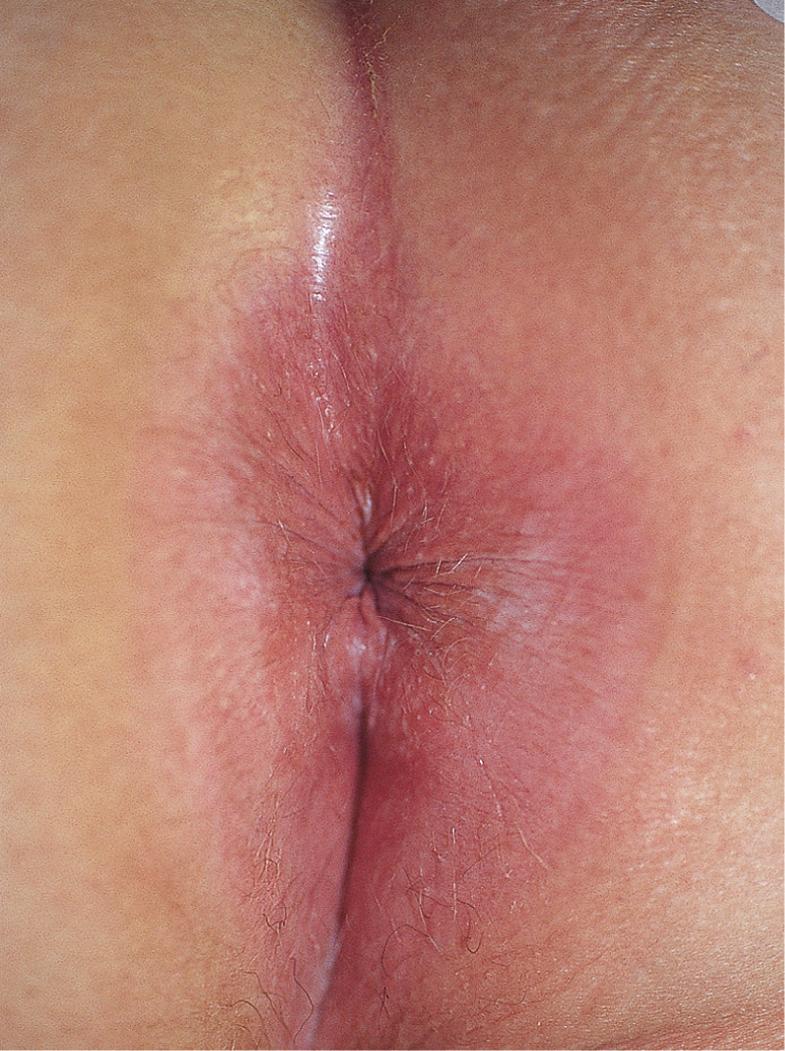
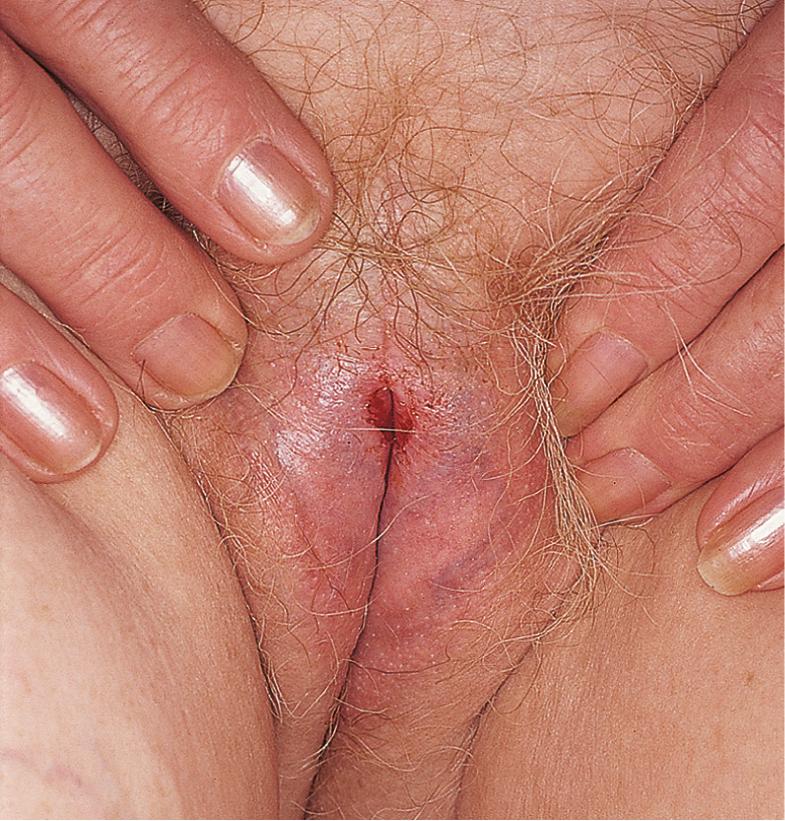
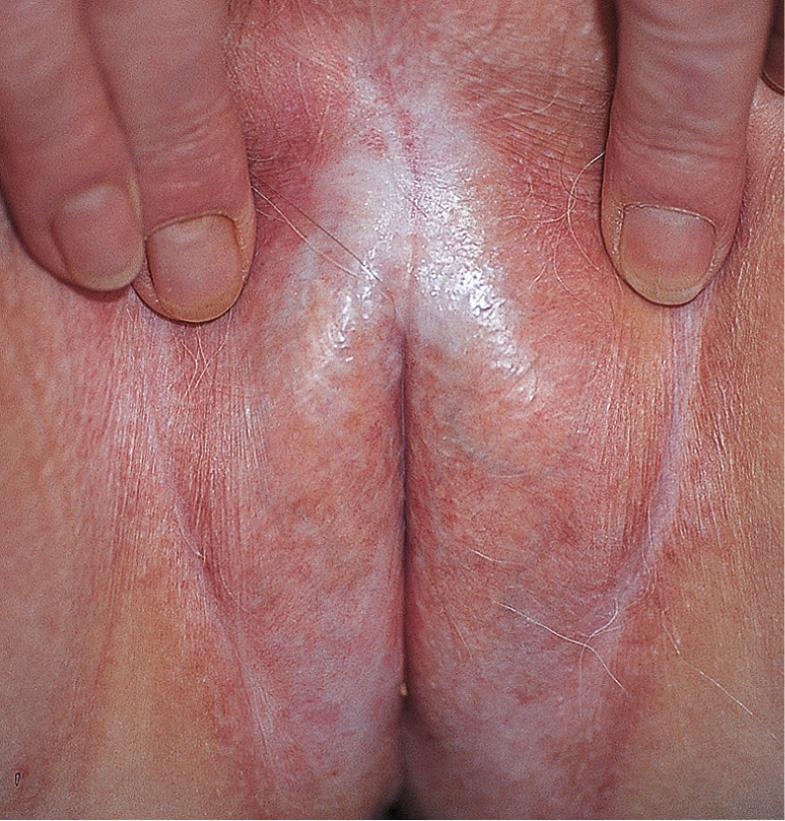
Lichen sclerosus affects the glans penis and foreskin of men ( Fig. 73.5 ) and, in contrast to women, involvement of the perianal region is uncommon. The disease usually presents with pruritus, pain, and dyspareunia. Affected boys may have recurrent balanitis and a poor urinary stream, and some may require circumcision.

Extragenital lichen sclerosus favors the submammary region, as well as the shoulders, neck and wrists, presenting as asymptomatic, hypopigmented, wrinkled patches with follicular plugging (see Ch. 44 ); occasionally, there are multiple guttate lesions. The diagnosis is established by a combination of the characteristic clinical and histologic findings.
The principal histologic findings are compact orthokeratosis, follicular plugging (in non-mucosal sites), a thinned epidermis, vacuolization of the basal layer, and hyalinization of the papillary dermis. A deep band-like lymphocytic infiltrate is often observed. Squamous hyperplasia may be present and may be associated with an increased risk of SCC. In bullous lichen sclerosus, there is extensive vacuolar degeneration of the basal layer with clefting and hemorrhage is often seen. Early on, the papillary dermis may be edematous and homogenous, but, with time, hyalinization and sclerosis are observed.
Histologic examination of the skin is imperative as it can be difficult to distinguish lichen sclerosus from mucous membrane (cicatricial) pemphigoid or erosive lichen planus on the basis of clinical appearance alone. Occasionally, despite marked clinical changes, the disease cannot be confirmed histologically and repeat biopsies over time may be needed to establish the diagnosis. In lesions that have been treated with potent topical corticosteroids, ascertaining the diagnosis histologically may prove challenging.
Very mild or early disease may be confused with dermatitis. The presence of vulvar scarring necessitates the exclusion of other scarring disorders such as erosive lichen planus and mucous membrane pemphigoid. The absence of oral or vaginal mucosal involvement helps to distinguish lichen sclerosus from erosive lichen planus. In children, sexual abuse must be considered, realizing that lichen sclerosus and sexual abuse are not mutually exclusive.
The principal differential diagnosis is:
erosive lichen planus
vulvar eczema
lichen simplex chronicus
morphea
mucous membrane pemphigoid
child sexual abuse
The main aim of therapy is to bring the disease under control as quickly as possible with the fewest side effects. For initial treatment (after the diagnosis is established), a potent topical corticosteroid such as clobetasol propionate 0.05% ointment is prescribed. One regimen is daily application of clobetasol propionate 0.05% ointment to the affected area for 3 months . This alleviates symptoms in the majority of patients, often within weeks. Subsequently, the corticosteroid is tapered over 2 weeks and clinical remission maintained by limited (typically twice weekly) application of a corticosteroid, using less than 30 g in any 4-month period. The potency of the corticosteroid chosen depends on whether symptoms and signs are controlled. In some patients, there is complete resolution of signs as well as symptoms, with the exception of scarring, which is irreversible .
In the management of lichen sclerosus without secondary SCC, there is no longer a role for vulvectomy. Nor is there a role for testosterone cream as it may cause virilization and when compared to petrolatum alone had a similar response rate. For longstanding disease in which narrowing of the introitus has resulted in dyspareunia, surgical refashioning with division of adhesions may be helpful. Vaginal dilators may also be needed, as well as psychosexual counseling.
Longitudinal evaluation is essential for patients with lichen sclerosus because both men and women are at increased risk of developing genital SCCs (estimates of the risk are 2–5%). Women with lichen sclerosus may develop differentiated vulvar intraepithelial neoplasia (VIN) which has a higher risk of developing into invasive SCC compared to undifferentiated VIN (HPV-associated disease). Men are at risk of penile intraepithelial neoplasia. Non-healing fissures, ulcers or nodules must be examined histologically. Written educational material and patient support groups are very helpful. It is essential that patients who notice any features of malignancy seek prompt medical assessment.
The first- and second-line therapies for anogenital lichen sclerosus are outlined in Table 73.1 . Several case series have demonstrated success with topical calcineurin inhibitors; however, the risk of long-term treatment of lichen sclerosus with topical calcineurin inhibitors is unknown. Therefore, given the potential for malignant transformation in this condition, the authors caution against chronic maintenance therapy.
| THERAPIES FOR ANOGENITAL LICHEN SCLEROSUS |
|---|
| First-line |
|
| Second-line |
|
▪ Vulvovaginal gingival syndrome (erosive lichen planus in women) ▪ Peno-gingival syndrome in men ▪ Mucosal lichen planus
Four distinct forms of genital lichen planus are observed: (1) papules or plaques in the setting of generalized cutaneous lichen planus; (2) erosive disease; (3) hypertrophic disease; and (4) lichen planopilaris
Although cutaneous disease is often self-limiting, mucous membrane disease is more persistent
The classic findings in cutaneous disease are violaceous, flat-topped papules and plaques; lacy white streaks typically occur on the genitalia as well as the oral mucosa
Erosive lichen planus often involves multiple mucous membrane sites – in particular, the vulva, vagina, and oral mucosa
Approximately 50% of women and 25% of men with cutaneous lichen planus have genital involvement. The classic violaceous papules and plaques typically affect the labia minora and majora or the mons pubis in women and the glans or shaft of the penis in men. Erosive lichen planus is a distinct subtype of the disease, characterized by severe, scarring erosive disease of the vestibule, introitus, vagina, and oral cavity . Hypertrophic genital lichen planus and lichen planopilaris are the least frequent forms.
Erasmus Wilson reported a patient with vulvar lichen planus in 1867, but the first histologic description of lichen planus was by Darier in 1909. Isolated case reports of vaginal involvement with vaginal discharge and hyperemic vaginal mucosa appeared in the 1950s, and the term “desquamative inflammatory vaginitis” was introduced in 1968. Fourteen years later, Pelisse recognized erosive lichen planus as a distinct subtype of lichen planus and gave it the name “vulvo-vaginal-gingival syndrome” .
Lichen planus is more common in women, generally presenting in the sixth decade. The exact prevalence is unknown, but it is likely that some cases of genital involvement in cutaneous lichen planus may be missed.
Lichen planus probably represents T-cell-mediated damage to epidermal cells that express altered self or foreign antigens on their surface, but the exact etiology is unknown (see Ch. 11 ). There is an autoimmune phenotype (see above) in female patients with vulvar lichen planus and an association with autoimmune disease . While some cases of lichen planus may be drug-induced, there are no definite associations with genital disease. Infectious triggers, particularly hepatitis C viral infection, may be associated with mucosal lichen planus in certain parts of the world such as the Mediterranean basin and Japan.
There are four distinct presentations of genital lichen planus , as follows:
In classic lichen planus, the genital lesions are similar to those in other cutaneous sites but lacy reticulation may be very prominent. Genital involvement is usually limited to the mons pubis and the labia majora and minora in women or the glans penis and shaft in men (see Ch. 11 ). Penile plaques are frequently annular ( Fig. 73.6A ). Scarring is not a feature of classic lichen planus. Severe cutaneous pruritus is the usual presenting symptom, but genital lesions may be asymptomatic. Lesions are usually self-limited.
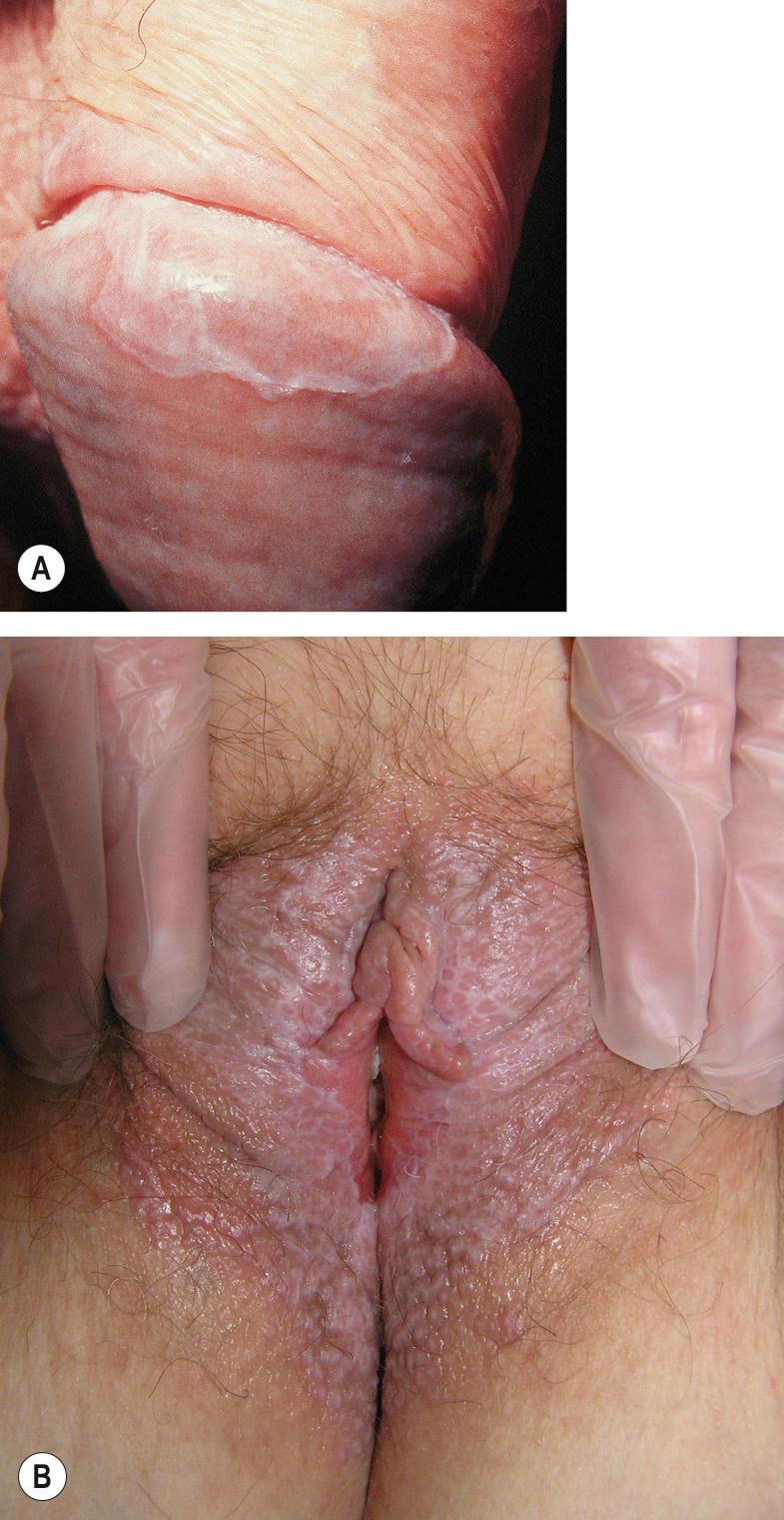
Erosive lichen planus occurs much more frequently in women than in men. Pain and dyspareunia are the most common complaints. In female patients, extensive erosions occur around the vaginal orifice, edged by lacy white reticulations; similar lesions may also occur on the labia ( Fig. 73.6B ). Erosive lichen planus frequently leads to scarring, resulting in distortion of the vulvar architecture . In severe cases, there may be complete obliteration of the vaginal canal and urinary retention. Vaginal involvement can present with a discharge, erythema and contact bleeding of the vaginal mucosa, and/or scarring with adhesions. Oral involvement is frequently observed, usually in the form of a desquamative gingivitis, but lacy white reticulations and erosions may also occur. Erosions limited to the perianal area alone have been described.
In the hypertrophic form of lichen planus, hyperkeratotic white plaques on the vulva or shaft of the penis may be seen.
In lichen planopilaris, follicular keratotic papules are limited to the hair-bearing labia majora and the mons pubis, but may also be seen on the scalp and trunk and in the axillae.
The typical histologic findings are irregular epidermal acanthosis, accentuation of the granular layer, liquefactive degeneration of the basal layer, and a band-like dermal infiltrate of lymphocytes. It is more difficult to interpret biopsy specimens of mucous membranes, where these findings are more variable. Because there is loss of the epithelium in erosive disease, the specimen should include the edge of the erosion as well as the surrounding lacy reticulated skin. Despite this, it is sometimes difficult to unequivocally confirm the disease, but histologic evaluation can aid in excluding other disorders in the differential diagnosis.
The principal differential diagnosis is:
lichen sclerosus
autoimmune bullous disease, including mucous membrane pemphigoid
graft-versus-host disease
plasma cell vulvitis
Behçet disease
vulvar intraepithelial neoplasia or SCC
Direct immunofluorescence may be necessary to exclude an autoimmune bullous disease. Orogenital ulceration raises the possibility of Behçet disease (see Ch. 26 ). Early lichen planus may be confused with vulvar eczema and there may be superimposed lichen simplex chronicus. For hypertrophic disease, vulvar intraepithelial neoplasia, SCC, and lichen simplex chronicus are the major entities in the differential diagnosis.
The treatment of genital lichen planus is outlined in Table 73.2 . Potent or moderately potent corticosteroid ointments will control most symptoms of classic genital lichen planus, as the disease is usually self-limiting. Hypertrophic disease may require intralesional corticosteroids.
| THERAPIES FOR ANOGENITAL LICHEN PLANUS |
|---|
| First-line |
| Second-line |
|
* Available for the treatment of inflammatory bowel disease.
The management of erosive lichen planus is more difficult, as the disease is often more persistent . The majority of patients will respond to a 3-month course of topical clobetasol propionate 0.05% (as described for lichen sclerosus ) and thereafter can be maintained on moderately potent corticosteroids. A combination of a moderately potent corticosteroid with a topical antifungal cream (e.g. econazole) may be as effective as more potent corticosteroids, particularly for maintenance therapy. For refractory disease, anecdotal case reports describe benefit from topical tacrolimus, systemic immunosuppressants (e.g. mycophenolate mofetil), and oral hydroxychloroquine. Low-dose weekly methotrexate, as for oral erosive lichen planus, may be helpful for severe disease. Tricyclic antidepressants can be used to treat associated vulvodynia. Erosive vaginal disease may require surgery to lyse adhesions, and the regular use of vaginal dilators with a corticosteroid ointment is necessary to prevent recurrence.
Long-term evaluation of these patients is advised because of the risk of malignant transformation ; the incidence of the latter has been estimated to be ~2.4% . For further details on the treatment of lichen planus, including systemic agents for severe, refractory disease, see Chapter 11 .
▪ Plasma cell balanitis/vulvitis ▪ Vulvitis/balanitis circumscripta plasmacellularis ▪ Zoon's erythroplasia
Male predominance
Erythematous, moist, speckled, discrete plaques
Involvement of adjacent surfaces produces “kissing” lesions in men
In men, cured by circumcision
There is no doubt that this condition occurs in men, but its existence as a separate entity in women has been questioned. Many of the clinical features in women are indistinguishable from those of erosive lichen planus, mucous membrane pemphigoid or lupus erythematosus, and the lichenoid features histologically overlap with erosive lichen planus.
Zoon balanitis/vulvitis may occur at any age but is usually seen from the third decade onwards in uncircumcised men and in postmenopausal women.
The etiology is unknown, but poor penile hygiene or chronic irritation from warmth or rubbing has been suggested. In women, hormonal factors may play a role. The condition does not occur in circumcised men.
In men, the lesions on the glans penis may be asymptomatic or give rise to pruritus or dysuria. The lesions are erythematous, discrete, moist plaques with a “cayenne pepper” speckled appearance and a reddish brown hue. “Kissing” lesions with involvement of adjacent, touching areas, e.g. around the urethral meatus, are a characteristic finding ( Fig. 73.7 ). Shallow erosions may resolve slowly, leaving a rusty color. In women, erythematous plaques similar to those in men may be seen anywhere on the vulva. Lesions may be asymptomatic or cause dyspareunia, dysuria, pruritus, or pain.
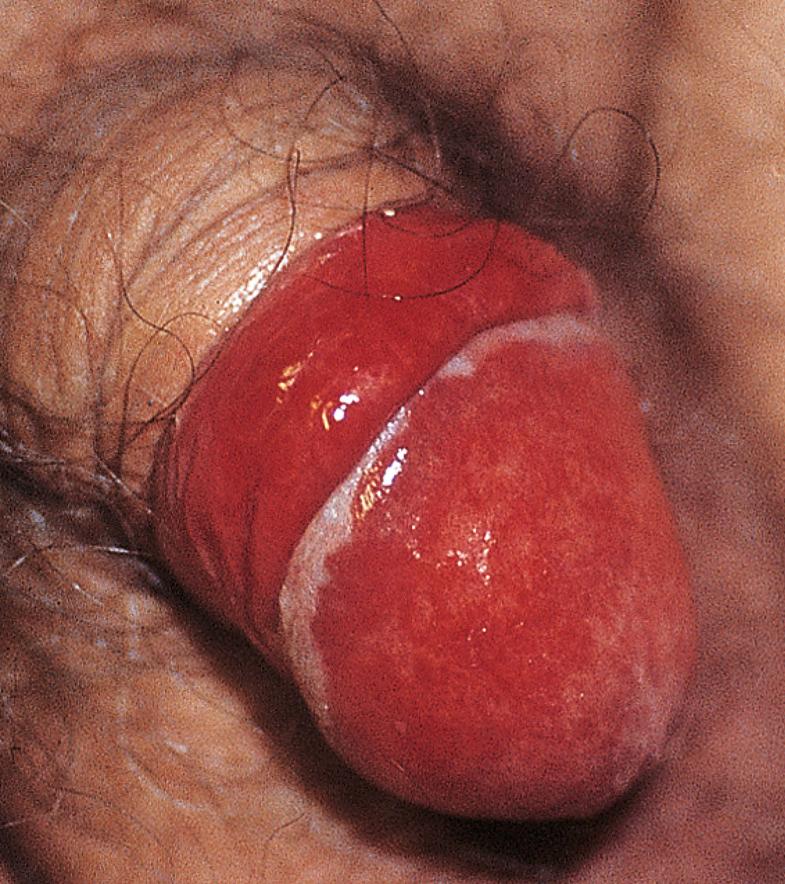
The typical histologic picture is a dense lichenoid infiltrate in the upper and mid dermis with a predominance of plasma cells. Additional features include “lozenge-shaped” keratinocytes, vascular proliferation, hemosiderin deposition, and erythrocyte extravasation.
In order to establish the diagnosis, a biopsy is usually performed. The major disorder in the differential diagnosis is erosive lichen planus, but the possibility of cutaneous malignancy (e.g. SCC in situ , extramammary Paget disease) must be considered.
In men, a circumcision will almost always cure the disease. Potent topical corticosteroids or topical calcineurin inhibitors may provide some symptomatic relief . Vaginal estrogen may be helpful for some women.
Appearance ranges from mild erythema to marked lichenification
Pruritus and soreness are the main complaints
A mixed etiology is common
Exogenous irritants and allergens must be sought
Although anogenital dermatitis has traditionally been subdivided into endogenous dermatitis (e.g. seborrheic dermatitis, atopic dermatitis), lichen simplex chronicus, and exogenous dermatitis (e.g. allergic or irritant contact dermatitis), in practice it is often difficult to distinguish between subtypes. A mixed picture, in which endogenous dermatitis is worsened by exogenous irritants or allergens, is common. Lichen simplex chronicus may develop secondarily to other anogenital diseases such as candidiasis, psoriasis, and lichen sclerosus.
The majority of patients with vulvar dermatitis have an endogenous predisposition, having either an atopic background or seborrheic dermatitis . The anogenital area is susceptible to irritants, and allergic contact dermatitis is very prevalent in this site; the latter is usually due to topical medications or personal hygiene products (e.g. “wet wipes” that contain methylisothiazolinone). Psychological issues and local environmental problems such as heat, sweating, and over-cleansing may be contributing factors.
The cutaneous features are varied, ranging from mild, usually poorly demarcated erythema to severe lichenification ( Fig. 73.8 ). Symptoms include pruritus ( Figs 73.9 & 73.10 ), pain, and superficial dyspareunia in women. In lichen simplex chronicus, scratching or rubbing is associated with unremitting pruritus. Fissuring is common, especially perianally. The typical anogenital sites affected are the labia majora and the mons pubis in women, the crura and scrotum in men, and the perianal area in both sexes. Lichenification is most often seen on the scrotum in men and the labia majora in women. Signs of seborrheic dermatitis (e.g. a scaly scalp, greasy scaling and erythema of nasolabial folds and eyebrows), as well as erythema at other flexural sites such as the inframammary crease, intergluteal fold and axilla, should be sought. Atopic dermatitis at other sites will usually be obvious from the history or examination.
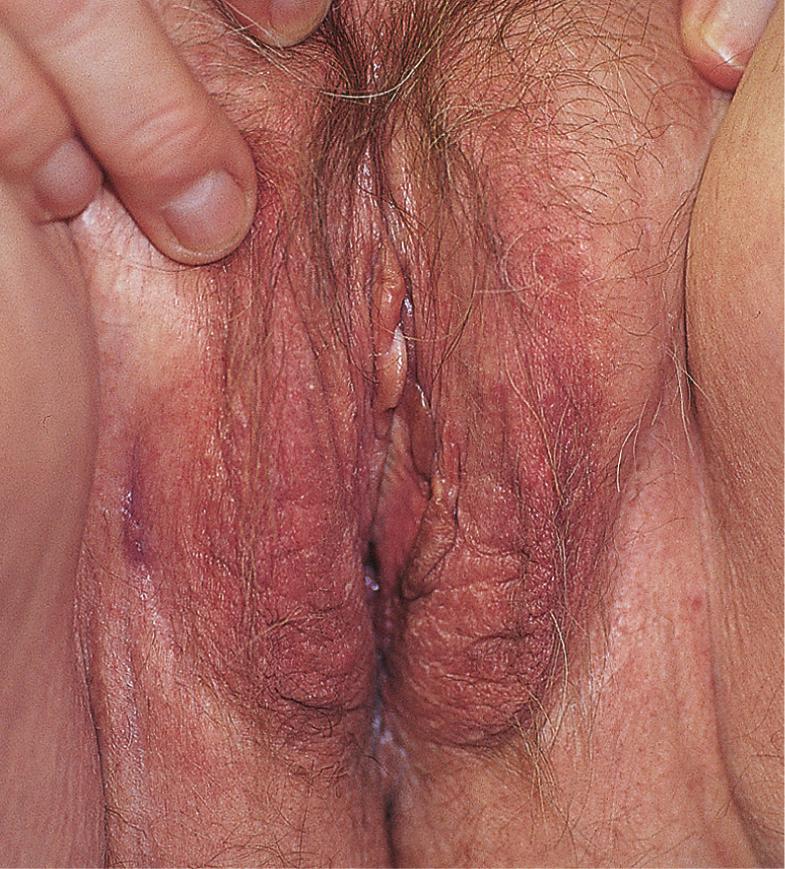
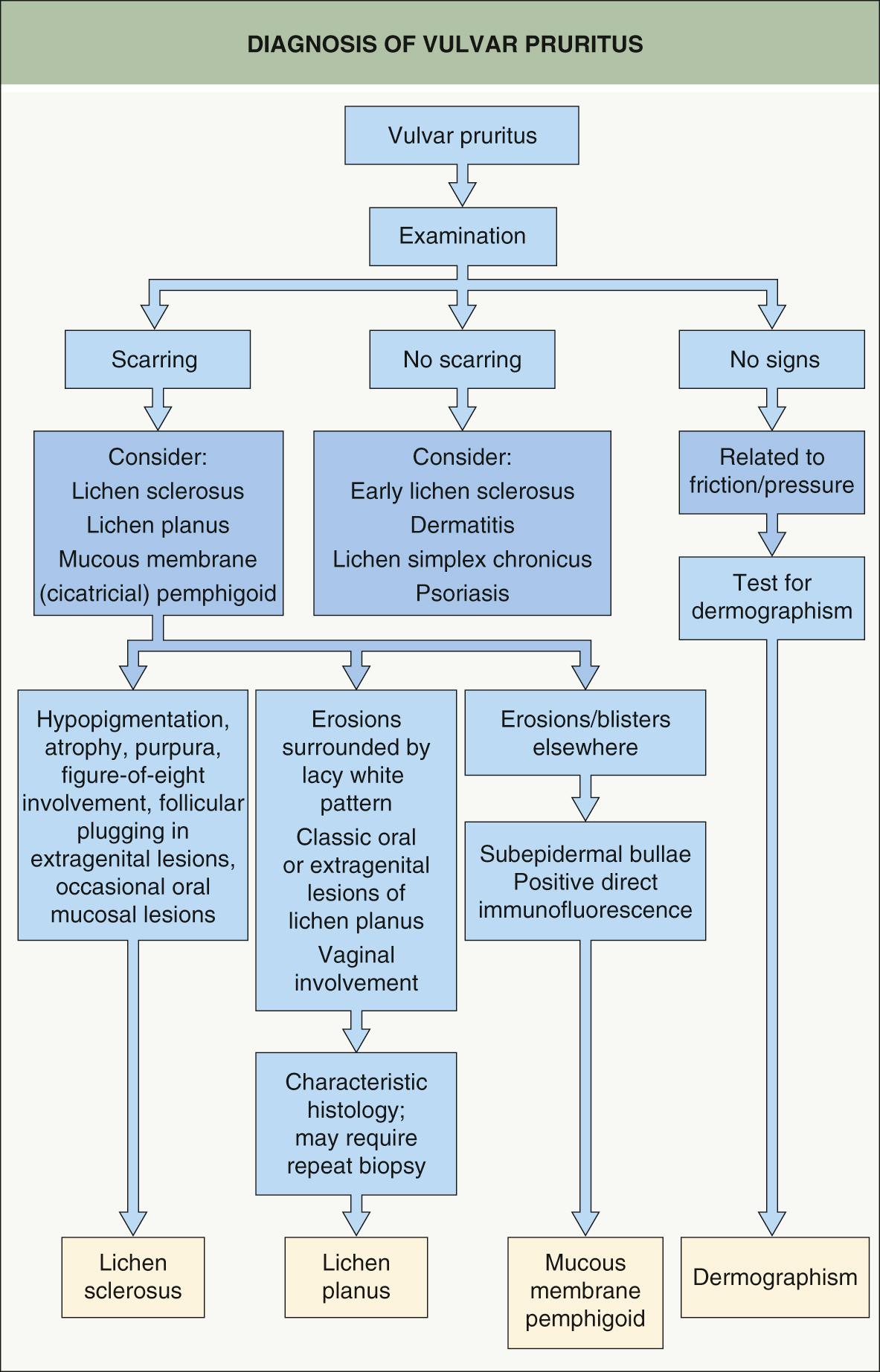
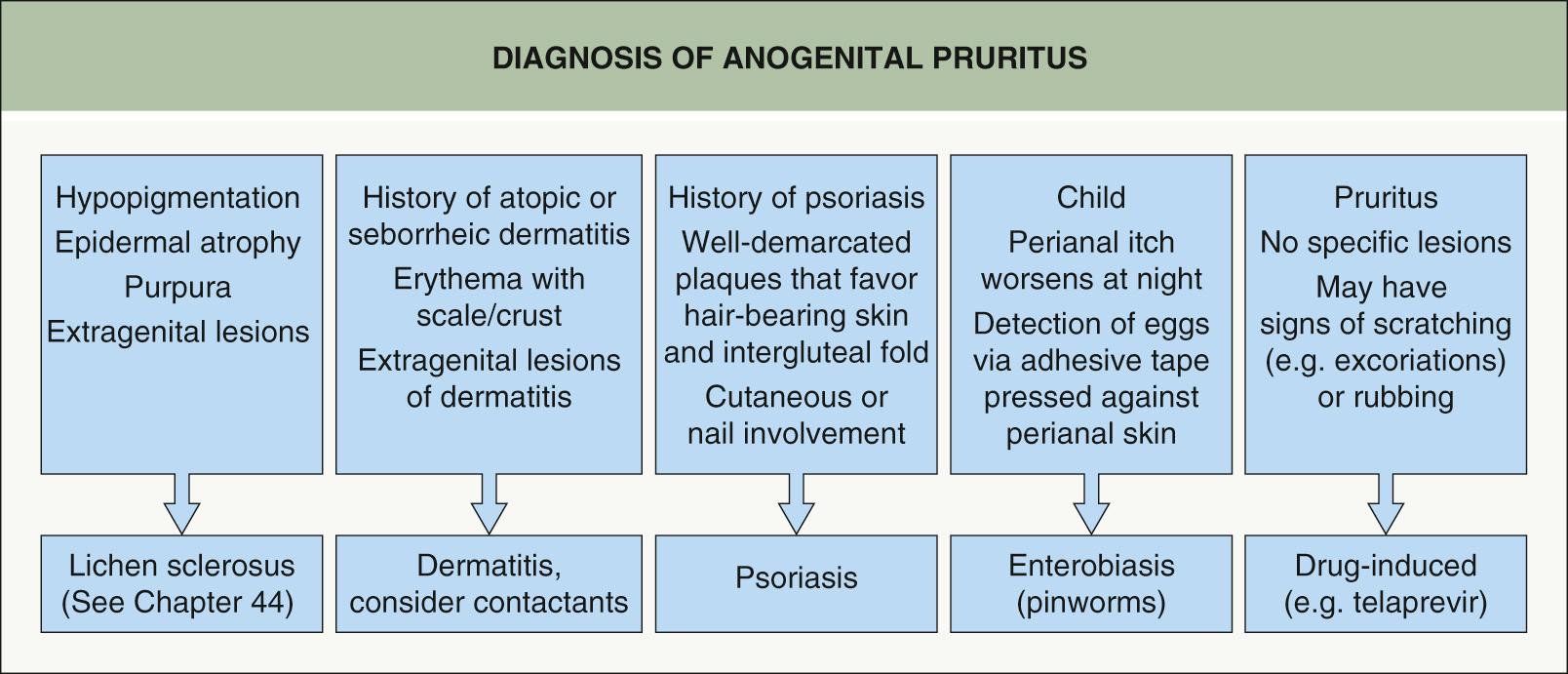
The key to making the diagnosis is a thorough dermatologic examination. The diagnosis is usually made on the basis of clinical appearance, but a skin biopsy can be helpful in excluding other diagnoses. For example, plaques of psoriasis are more well-circumscribed than those of dermatitis. Extramammary Paget disease should also be considered, but these lesions are also sharply demarcated and usually asymmetric. It is important to identify irritants and possible allergens through a careful history and possibly patch testing. In addition, bacterial and Candida cultures should be performed to exclude superimposed infection, which is common in the anogenital region. Early lesions of lichen sclerosus may be indistinguishable from dermatitis.
The regular use of bland emollients and the substitution of an emollient for soap is recommended. Exacerbating factors, including stress, heat, excessive washing, use of premoistened personal hygiene wipes (“wet wipes”) and candidiasis, should be identified. A major therapeutic aim is reduction of pruritus and soreness . If the area is acutely inflamed, potent topical corticosteroids, often in combination with topical antifungal agents, topical antibacterial agents and/or topical immunomodulators, are helpful. Over a period of a few weeks, the topical corticosteroid can be tapered to one that is less potent. When lichenification is present, it is especially important to break the itch–scratch cycle. Additional therapies include sedative antihistamines or tricyclic antidepressants, usually doxepin, at bedtime (see Ch. 6 ).
It is important to consider the possibility of contact dermatitis in any patient with dermatitis, a history of reactions to topical medications, or treatment-resistant disease. Contact dermatitis of the anogenital region may be irritant or allergic (see Chs 14 & 15) . Irritant contact dermatitis is seen in infants as diaper dermatitis and in older patients as a consequence of overzealous cleaning, urinary or fecal incontinence, or chronic diarrhea.
Allergic contact dermatitis of the anogenital region occurs in men and women . Relevant allergens include preservatives, fragrances, topical anesthetics, corticosteroids, rubber chemicals, and spermicides. Type I immediate hypersensitivity reactions may occur to latex and seminal fluid. Allergic contact dermatitis must be considered in all patients with perianal dermatitis, because medications (topical, per anum) are frequently used by both sexes. Hemorrhoid creams and medicated toilet wipes are common culprits.
Erythematous well-defined plaques
Evidence of psoriasis elsewhere on total body skin examination
Intergluteal cleft frequently affected
Poor response to treatment
Psoriasis of the anogenital region may appear quite different from psoriasis at other sites (see Ch. 8 ). The typical silvery scale is lost, as in other flexural sites such as the axillae and submammary region.
In women, erythematous, smooth, clearly demarcated plaques typically affect the labia majora and the mons pubis. Psoriasis is usually confined to the hair-bearing areas, so the labia minora are unaffected. Men may have circumscribed plaques on the glans penis and shaft of the penis ( Fig. 73.11 ). Persistent, painful fissuring of the perianal area and the intergluteal cleft can be a severe problem in both sexes.
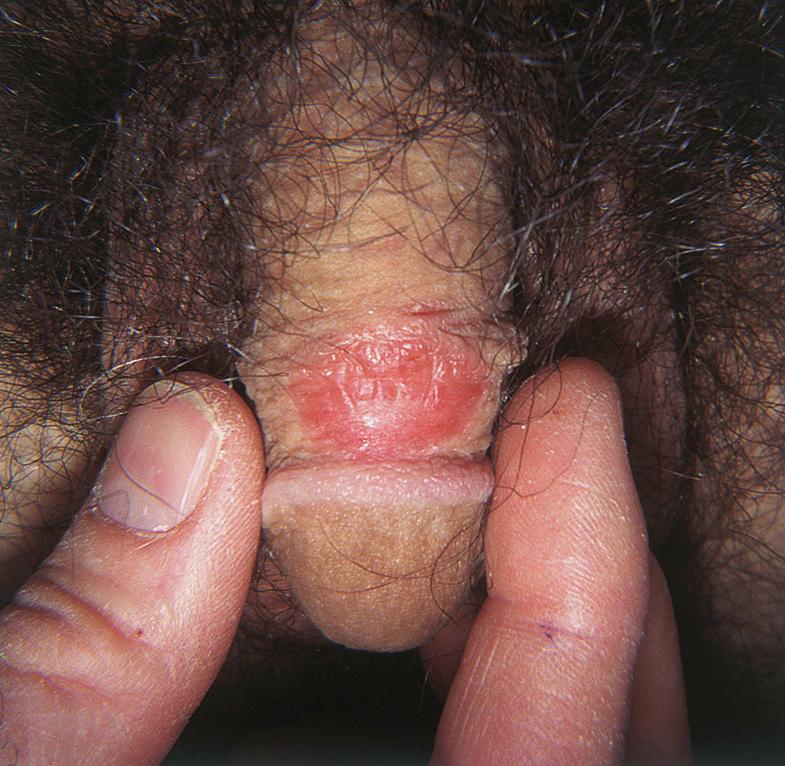
Become a Clinical Tree membership for Full access and enjoy Unlimited articles
If you are a member. Log in here